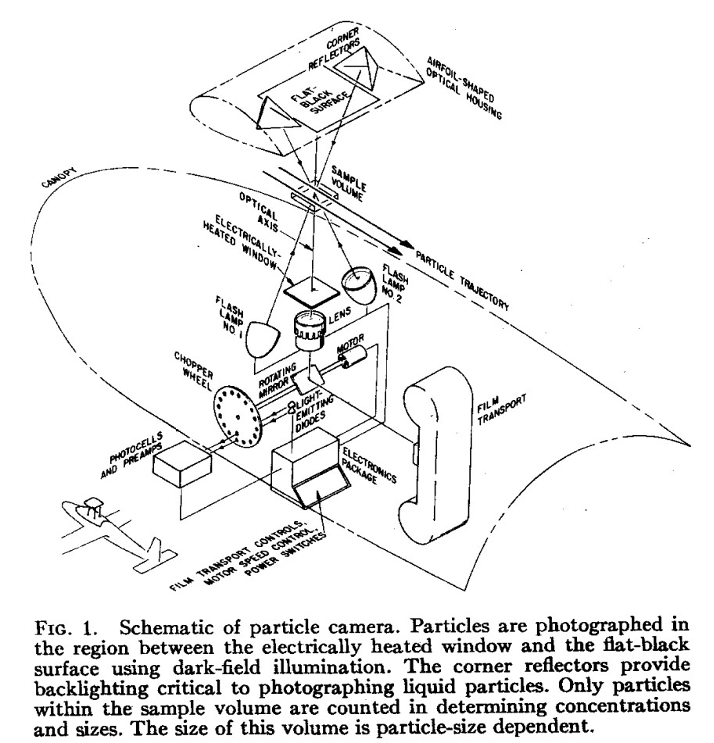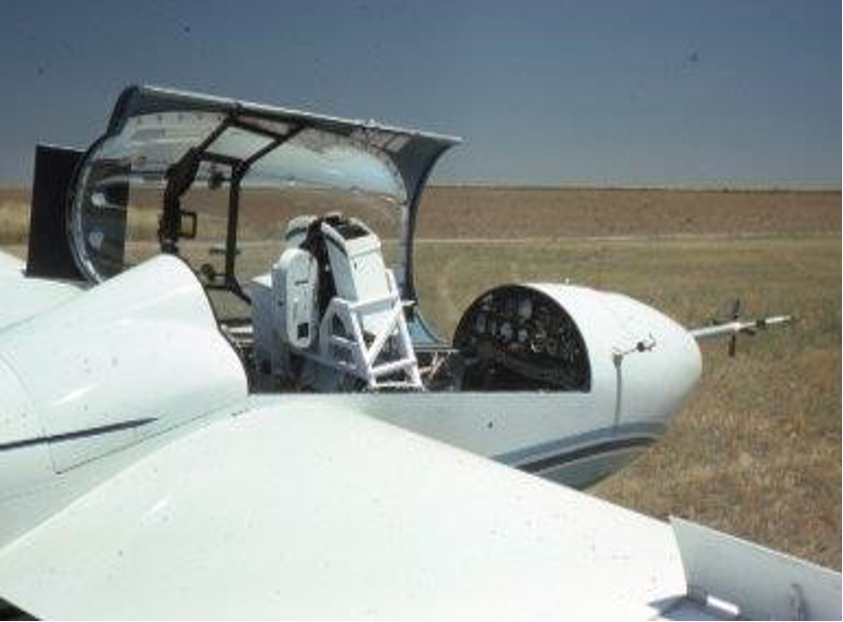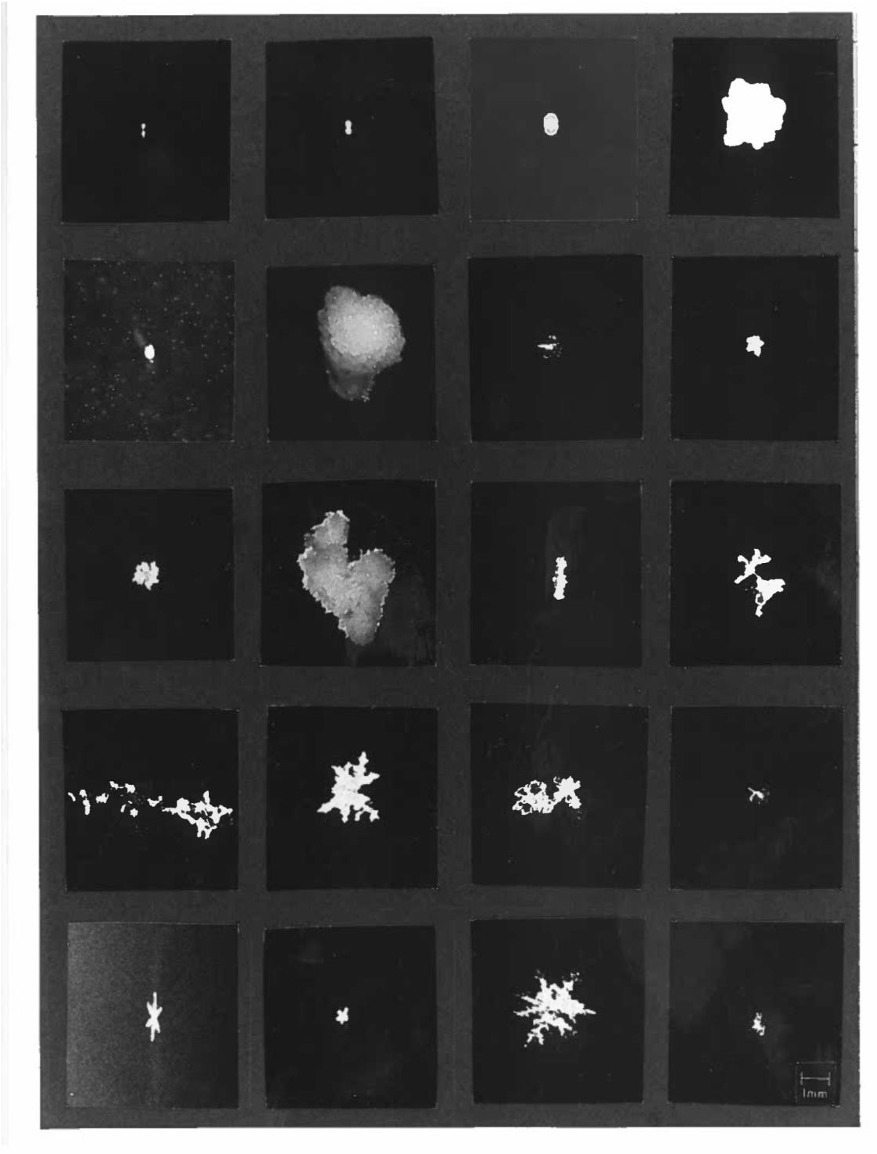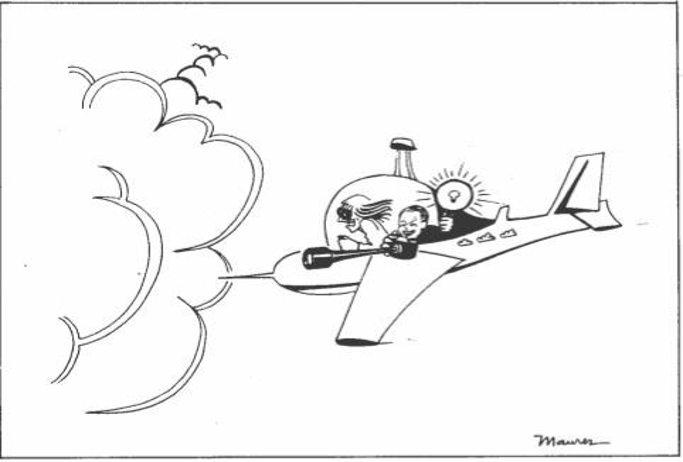The Cloud Particle Camera (CPC) was a major step ahead for continuously documenting the types and concentrations of particles inside clouds. Prior to the existence of the CPC on Explorer, observations of cloud and precipitation particles were often made by the pilot or observer noting the impacts of particles on the windscreen or by holding black velvet or soot-coated microscope slides momentarily in the airstream for particle impaction and in flight or later post-flight examination. A few places such as the University of Chicago also used foil impactors (Brown 1961 reference) and decelerator tubes than brought precipitation particles into the fuselage for direct viewing or formvar replication. (Braham, 1964, Koenig, 1963). All these methods resulted in highly inaccurate measurements due to cloud particle breakage on impact. Additionally, there were aerodynamic, flow-induced errors resulting from sorting of the particles: the smaller particles would pass around the instrument, while the larger particles would enter. There was a serious need for an instrument that would make these measurements in situ, that is in the particle’s natural state, with minimal deleterious effects on the particles due to the presence of the aircraft and instrument.
During the years 1969-1979 Ted Cannon at NCAR developed a high-speed camera for photography of cloud particles from aircraft. This work started with the development of various cameras for photographing these particles in the laboratory and in atmospheric clouds in Yellowstone National Park in the winter. This work led to a camera used for atmospheric cloud particle research. It was first designed for and installed on Explorer in 1971 and continued to be flown on the sailplane until 1985. The particle camera was so successful that in the mid 1970s one was designed and constructed for use on the South Dakota School of Mines and Technology T-28 storm penetrating aircraft and also for the Univ. of Chicago aircraft. The current description is about Explorer version of the camera. Use of the Cloud Particle Camera enabled almost continuous determination of the phase, size, shape characteristics and estimates of concentrations of particles larger than about 200 µm during ascents of Explorer in cumulus congestus clouds. A schematic of the Cloud Particle Camera from Cannon’s 1974 article in the Review of Scientific Instruments (Cannon, T.W., 1974) is shown in Fig. 16 below.
Fig.16 Duplication of the original figure shown in Cannon, 1974.
Fig. 17 A photograph of Explorer during NHRE viewed from the starboard side with the canopy open. The onboard CPC components are visible immediately in front of the observer’s (rear) seat. The camera is set up with the high-capacity film magazine. The starboard high-speed flash lamp is seen attached to the white camera framework to the immediate right of the film mechanism. The reverse flow temperature probe is just ahead and on the right side of the cockpit. The electrostatic disdrometer for measuring cloud droplets and four polonium radioactive sensors for attempting measurements of two components of the electric field are mounted on the boom extending from the nose of the sailplane. The flaps or lift spoilers (dive brakes) are shown extended on the far right of the wing.
Although the camera was first installed in March 1971, it took much effort and troubleshooting, especially on the part of Cannon, for the CPC system to work reliably. In 1971 into 1973 he flew as observer/camera operator in the back seat of Explorer. Initially the CPC utilized a standard Nikon motorized back which held 250 frames of 35 mm film. But beginning in 1974 a specially built high-capacity magazine and extra thin base film, Kodak RAR 3498 allowed about 3200 frames to be loaded for the camera. At a frame rate of two frames per second this provided continuous particle measurements for a period of 27 minutes. For more information on the particle camera on Explorer see Cannon, 1974. Some examples of photographs of particles from the CPC are shown in Fig. 18 with a description of each image in Table IV below the figure.
Fig. 18. Photographs of particles taken by the Cloud Particle Camera in 1972, 1973 and 1974. A 1 mm scale is faintly shown in the lower right corner.
Table IV Description of Images from the Particle Camera shown in Figure 9
|
Row/Col |
Description/Comment |
Date |
|
1/1 |
In-Focus Raindrop in Precipitation below cloud. Separated Two-Dot Signature |
6/12/73 |
|
1/2 |
Slightly out-of-Focus Raindrop in Precipitation Merged Two-Dot Signature |
6/12/73 |
|
1/3 |
Out-of-Focus Raindrop in Precipitation, Overlapped Camera Aperture Signature |
6/12/13 |
|
1/4 |
Graupel at 4.3 km msl, 0 oC. Out of Cloud Overexposed |
7/28/71 |
|
2/1 |
Graupel and Cloud Droplets 6.3 km, -13 oC Inside Cloud |
6/15/73 |
|
2/2 |
Large Graupel Particle 3.1 km, 6.2 oC. Outside of Cloud |
6/15/73 |
|
2/3 |
Frozen Drop 2.1 km, -10 oC. Out of Cld. Note spicule from freezing of supercooled water drop. |
6/20/73 |
|
2/4 |
Ice Particle in Cloud 7.2 km,. -21 oC, In cloud. No cloud droplets observed at this location |
7/15/73 |
|
3/1 |
Ice Particle 7.1 km, -20 oC, In cloud. No cloud droplets observed at this location |
7/6/73 |
|
3/2 |
Ice Particle 5.7 km,-1.5 oC, In cloud. No cloud droplets observed at this location |
7/14/74 |
|
3/3 |
Ice Particle 4.5 km, -0.5 oC, Out of Cloud |
8/4/74 |
|
3/4 |
Ice Particle 4.4 km, 0 oC, Out of Cloud. |
8/4/74 |
|
4/1 |
Ice Particle 4.4 km, 0 oC, Out of Cloud |
8/4/74 |
|
4/2 |
Ice Particle 4.6 km, -1 C, Out of Cloud |
8/4/74 |
|
4/3 |
Ice Particle 4.3 km, 0 oC, Out of cloud. |
8/4/74 |
|
4/4 |
Ice Particle in Seeded Cloud 6.7 km, -13 oC, Note: Spicule on frozen water drop. No cloud droplets |
8/30/74 |
|
5/1 |
Ice Particle in Seeded Cloud, 6.8 km, -13 oC. Shows Vapor Deposition, No Riming. No cloud droplets |
8/30/74 |
|
5/2 |
Ice Particle in Seeded Cloud 6.8 km, -14 oC, Dendritic form, no cloud droplets. |
8/30/74 |
|
5/3 |
Ice Particle in Seeded Cloud 6.8 km, -14 oC, Dendritic form with accretion, no cloud droplets |
8/30/74 |
|
5/4 |
Ice Particle in Seeded Cloud 6.8 km, -13 oC, Note Spicule of Frozen Water Drop. No cloud droplets. |
8/30/74 |
The uniqueness of the sailplane as a platform for cloud physics research and the cloud particle camera attracted attention both in NCAR and outside NCAR. A cartoon produced by the NCAR Information Office is shown in Fig. 19.
Fig. 19 A cartoon of Explorer about to enter a cloud with characterizations of Vim Toutenhoofd, pilot/scientist and Ted Cannon, observer, and developer of the Cloud Particle Camera.
The ability to photograph particles in a relatively undisturbed space at the slow true airspeed of the sailplane provided badly needed data to scientists studying the microphysical makeup of clouds. Determination of particle concentrations and physical detail was somewhat hampered by many of the images being out of focus. When further development of the camera was terminated in the spring of 1979 (but continued to be utilized on Explorer until 1986), Cannon was working on a two-color camera which would define the image volume by the color of the images vs. their sharpness, see Cannon, 1980.
- Explorer Participation in the National Hail Research Experiment (NHRE)
- Precipitation Formation via the Ice Process in NE Colorado
- The Discovery by Explorer of Adiabatic Ascent in Clouds of the High Plains
- Discovery of Penetrative Downdrafts
- Observation of a Counter Rotating Vortex Pair in a Cumulonimbus
- Explorer Observations of Silver Iodide Seeding in Cumulus Clouds
- Studies of Initial Cloud Electrification with Explorer
- Electrical/Microphysical Measurements in New Mexico
- Measurements on Explorer of Particle Charge, Size and Shape
- Flight in New Mexico to 40,200 ft with Particle Image and Charge Measurements
- Results from CaPE in Florida in 1991



